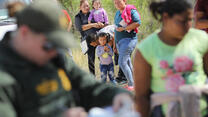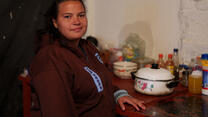
The horror of on-again off-again forced family separation at the United States-Mexico border is part of a global trend. In the midst of continued concern at the human cost, as well as bureaucratic confusion at the heart of Administration policy, it is vital that the bigger picture is not lost. This week the United Nations announced a record 68.5 million people forced from their homes by conflict and persecution, but the support for them is shrinking. U.N. aid appeals are less than 33 percent funded, while refugee resettlement to countries like the U.S. has been hacked back, by three-quarters in the U.S. case.
Children, who represent half of the world’s displaced, are particularly vulnerable. Globally there has been a recent surge, with over 300,000 unaccompanied and separated children crossing borders in 80 countries in 2015 and 2016—a five-fold increase from just five years earlier. A small minority have fled to the U.S., arriving at the U.S.-Mexico border after a long journey fraught with shocking levels of abuse and sexual violence.
President Trump’s Executive Order this week did not solve the crisis. It leaves children and families in limbo, continues to criminalize asylum-seeking—and could actually extend child detention. It’s also the latest in a string of choices to close safe and legal pathways for vulnerable populations to seek safety in the U.S.

By contrast, the International Rescue Committee’s programs in some of the poorest places in the world tell us five things children and families need to survive and thrive and should be in place at the southern border.
First, no external care can substitute for the support parents or other relatives offer children. That’s why family reunification is a legal norm as well as a moral necessity in refugee responses. There are shocking reports that some of the parents of the 2,300 children separated by U.S. authorities have been deported, raising the possibility these children may never see their parents again. All parents must be reunited with their children through family tracing immediately.
Second, reaching a border and claiming asylum is a legal right, not an illegal act. The test for refugee status is whether individuals can safely be returned home. If not, they must be allowed to stay. The key is that cases are processed quickly and fairly. Germany has shown it’s possible to reduce processing times when arrivals surge (down to just 8-10 weeks). Interviews and documentation are used to allow people to prove their case.
Third, children and their parents need basic humanitarian standards for safety, dignity and wellbeing. The videos and reports from the detention centers at the border paint a picture of prison-like conditions with unsanitary hygiene, overcrowding, and restricted movement. Even in poor, conflict environments, refugee camps are supposed to meet “Sphere Minimum Standards”—basic humanitarian requirements on sanitation, shelter, food, and protection from further harm. U.S. foreign assistance helps meet these standards. They are the bare minimum. It is vital that the U.S. sets a proper example of what material and legal protection should mean in the 21st century.
Fourth, children need support to address the trauma of war and displacement. These experiences in young children cause “toxic stress,” which inhibits brain development and can cause long-term damage unless managed by appropriate care and education. In the Middle East, the IRC and Sesame Workshop are pioneering the world’s largest early childhood development intervention in a humanitarian setting for children under eight years old, specifically to address this type of trauma. This sort of psychosocial support should be a vital lifeline for children arriving in the U.S. as well.
Fifth, children thrive when parents are able to do so. We know that refugee camps can become funeral homes for dreams when “temporary” structures become permanent holding pens. This is the story of the Dadaab refugee camp in eastern Kenya, one of the world’s largest, set up in 1992-1993 as a temporary shelter.
When refugees are able to work, the safety of women goes up and levels of violence against them go down. Social norms are re-established on a more secure footing when there is economic opportunity. Our research has also found that when refugee women are given cash payments, violence in the home decreases and school attendance goes up. The evidence is that the redistribution of economic power is a real driver of social change. And of course we know that once in the U.S. refugees on average pay more in taxes than they receive in benefits, and are more likely to start businesses than the national average.
It is ironic that some of the poorest countries of the world have lessons to teach the richest. Those lessons have often been learned using western development aid, including from the U.S. We know how to treat the symptoms of global tumult—and it is not through blaming the victims. They should be learned at the southern border, too.
The toughest question the Trump Administration needs to answer is how to address the source of these problems—the crisis of diplomacy and state-building from Syria to Honduras. If we really want to address the trauma of fleeing families, then we need to get serious about peace-building and peace-making. Only then will we be doing our duty.



